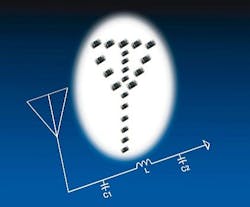WRIGHT-PATTERSON AFB, Ohio, 6 Feb. 2011. Scientists at the U.S. Air Force Research Laboratory at Wright-Patterson Air Force Base, Ohio, are sponsoring a project to develop radar-on-a-chip technology aimed at providing significant power savings for military electronic sensors like radar and infrared cameras.The Air Force Research Lab awarded a $9.2 million Small Business Innovation Research (SBIR) Phase 3 contract to Camgian Microsystems Corp. in Starkville, Miss., to develop ultra-low-power RF transceiver application-specific integrated circuits (ASICs) that will integrate Camgian’s low-power radar architecture with AFRL on radar-on-a-chip technology.The digital signal processing (DSP) architecture will be based on Camgian’s asynchronous NULL convention logic, which inherently provides data driven, self-timed circuits and supports advanced power management through sub-threshold transistor operation coupled with power gating plus dynamic power supply control.By minimizing energy consumption in logic circuits during active computation, Camgian achieves power consumption levels in key digital signal processing operations for infrared imaging systems that are about 20 times lower than existing integrated circuit technologies, company officials say.
The first phase of the AFRL research initiative will build on these results and focus on the key architectural components of the test chips, which are expected to tape-out in 2011.
"The goal of this program is to radically improve the operational endurance of key ground and airborne ISR [intelligence, surveillance, and reconnaissance] sensor assets while increasing both sensor performance and on-board digital signal processing capabilities," says Gary Butler, president and chief executive officer of Camgian Microsystems. "With this chipset, we are aiming to drive down the size, weight, power and cost of the systems while providing an ultra-energy efficient sensor and signal processing platform."
For more information contact Camgian Microsystems online at www.camgian.com.
